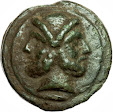The sixth coin in the series of cast coins from Luceria arrived today, the four dot thunderbolt / club.
Per Vecchi, between 280 & 220 BC, Luceria issued seven denominations with marks of value and the letter L. It is interesting to note that the letter L is an older form that was not used on Roman Republican coins after about 150 BC. The older L has less than 90 degree angle between the base line and vertical line. The weight of the coins dropped by more than a factor of 2 with time. My coins are from the second, smaller series. Five of the coins are shown in a group. The missing one is shown with its own photo (I will need to recheck my deposit box for the missing coin). There are three different versions of the As and one of the Semis. I do not have these coins. Obverse & reverse types are as follows:
Denomination / Mark of value / Obverse / Reverse
As, I - Hercules, Apollo or Janus / Horse head, horse or prow
Semis, S - Saturn / Prow
Quincunx, five dots - 4 spoke wheel / 4 spoke wheel
Quatrunx, four dots - Thunderbolt / Club
Teruncius, three dots - 6 point star / dolphin
Biunex, two dots, Shell / knucklebone
Uncia, one dot, Toad / grain ear
Semuncia, no dots, Crescent / garlanded thyrus





























